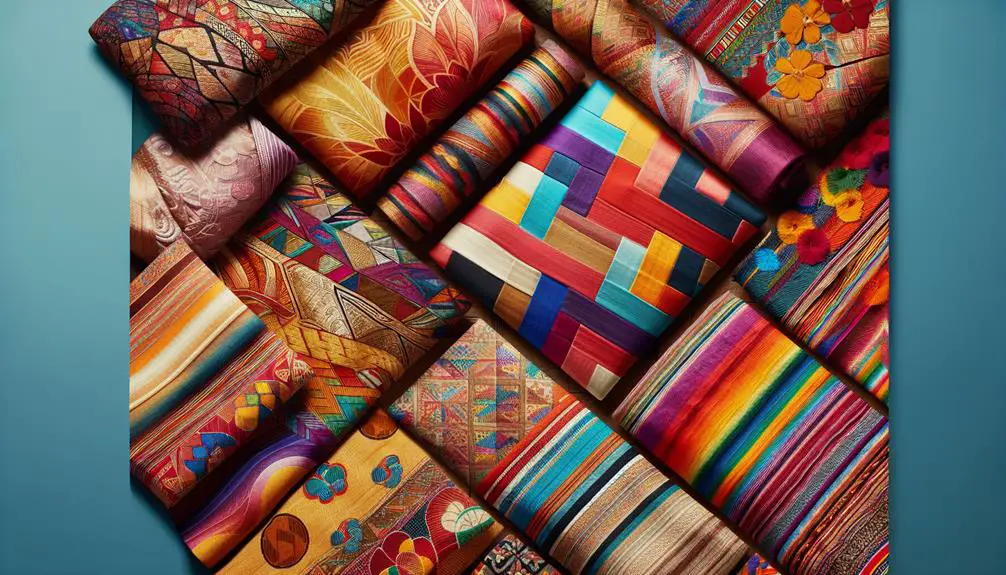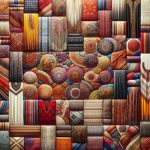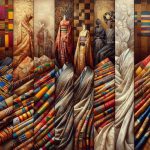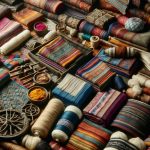Imagine running your fingers over the smooth, intricate silk of an Indian sari, feeling its centuries-old craft. When you explore traditional fabrics, you're not just looking at cloth but immersing yourself in a world where each thread tells a story. Consider the vibrant hues of African kente cloth or the meticulous patterns of a Japanese kimono. These fabrics speak of cultural pride, sustainability, and timeless artistry. You might wonder how these traditions started and what techniques they use; the answers reveal much about our interconnected global heritage. Ready to uncover these fascinating narratives?
Table of Contents
Key Takeaways
- Indian Silk Saris: Luxurious textiles with intricate designs reflecting India's vibrant heritage and meticulous silk weaving techniques.
- African Kente Cloth: Ghanaian cultural pride symbolized through colorful patterns and profound cultural significance.
- Japanese Kimono Fabrics: Intricate silk weaving, historical patterns, and natural dyeing techniques celebrating tradition and nature.
- Peruvian Alpaca Wool: Eco-friendly, hypoallergenic fabric offering unmatched warmth, durability, and softness.
- Indonesian Batik: Renowned for its intricate patterns and vibrant colors, representing a rich cultural heritage.
Indian Silk Saris
Indian silk saris are a vibrant reflection of the country's rich textile heritage. When you explore the world of silk saree styling, you'll uncover an array of intricate designs and luxurious textures that speak volumes about India's diverse culture.
To master silk saree draping, you need to understand the history behind these elegant garments. Originating from different regions like Banaras, Kanchipuram, and Mysore, each silk saree tells a unique story through its weave and pattern.
Taking care of your silk sarees ensures they remain timeless pieces in your wardrobe. Always store them in a cool, dry place, preferably wrapped in a muslin cloth to protect the delicate fabric. Avoid using harsh detergents; instead, opt for gentle hand washing or professional dry cleaning to maintain their luster.
Silk saree styling isn't just about wearing a piece of cloth; it's about embodying grace and tradition. Whether you're attending a wedding or a cultural event, the way you drape your silk saree can make a lasting impression. Practice different draping techniques to find the style that best complements your body and the occasion.
Mastering these aspects will elevate your appreciation and presentation of this timeless attire.
African Kente Cloth
Often regarded as a symbol of cultural pride and identity, African Kente cloth is renowned for its vibrant colors and intricate patterns. This traditional fabric, originating from the Ashanti Kingdom in Ghana, holds profound cultural significance. The weaving process, traditionally done on narrow looms, is a meticulous art passed down through generations.
Each color in Kente cloth carries specific meanings:
- Gold: Wealth and royalty
- Blue: Harmony and peace
- Green: Growth and renewal
- Red: Sacrifice and struggle
- Black: Maturity and spiritual energy
Understanding the color symbolism adds depth to your appreciation of this fabric.
Modern adaptations of Kente cloth have found their way into contemporary fashion, blending traditional elements with modern aesthetics. Designers worldwide are incorporating Kente patterns into everyday wear, accessories, and even home decor, ensuring the legacy of this fabric continues.
Japanese Kimono Fabrics
When you explore Japanese Kimono fabrics, you'll notice the intricate silk weaving techniques that have been perfected over centuries.
Pay attention to the historical fabric patterns that tell stories of Japan's rich cultural heritage.
Additionally, you'll find the dyeing and colors used in kimono fabrics reflect a deep connection to nature and tradition.
Silk Weaving Techniques
Traditional Japanese silk weaving techniques used for kimono fabrics showcase intricate artistry and centuries-old craftsmanship. When you immerse yourself in this world, you'll discover that silk production in Japan isn't just about creating a material; it's a revered tradition with deep cultural significance. The process starts with the meticulous care of silkworms, whose cocoons produce the fine threads essential for weaving.
Kimono fabrics incorporate various silk garment styles, each with unique characteristics and purposes. From the luxurious Furisode worn by young women during special ceremonies to the understated elegance of the Tomesode for married women, these garments reflect Japan's rich heritage. Modern interpretations of these styles often blend traditional techniques with contemporary fashion, ensuring the legacy continues to evolve.
To appreciate the depth of Japanese silk weaving, consider these key techniques:
- Kasuri: Creating intricate patterns by dyeing threads before weaving.
- Nishijin-ori: Combining silk with gold or silver threads for opulent designs.
- Shibori: A tie-dye technique resulting in unique, textured patterns.
- Yuzen: Hand-painting elaborate designs directly onto the silk fabric.
- Tsumugi: Using hand-spun silk threads for a rustic, textured finish.
Mastering these techniques not only enriches your understanding but also connects you to the enduring artistry of Japanese culture.
Historical Fabric Patterns
Japanese kimono fabrics boast a rich array of historical patterns that tell the story of the nation's cultural evolution. When you explore these fabrics, you'll find yourself immersed in ancient fabric traditions and historical textile techniques that have been passed down through generations.
Each pattern, whether it's the intricate cherry blossoms or the geometric asanoha, carries deep cultural significance and reflects the artistry and skill of Japanese textile artisans.
Traditional textile motifs in kimono fabrics aren't just decorative; they're symbolic. For instance, the crane symbolizes longevity and good fortune, while the pine tree stands for steadfastness and resilience. As you dive deeper, you'll notice that these motifs often align with the seasons, highlighting the Japanese appreciation for nature's cyclical beauty.
Mastering the historical fabric patterns of Japanese kimonos means understanding the context in which they were created. These fabrics weren't merely garments but storytelling canvases that conveyed social status, personal beliefs, and even political messages.
Dyeing and Colors
How do the vibrant dyes and colors in kimono fabrics capture the essence of Japan's rich cultural heritage? By using natural dyeing methods, artisans infuse kimonos with hues that aren't just visually stunning but also deeply symbolic. These colors tell stories, celebrate traditions, and convey emotions.
Natural dyeing methods involve using plant-based ingredients, minerals, and even insects. This ancient practice ensures that each kimono is unique and carries a piece of nature within its threads.
Here's what you should know:
- Indigo Blue: Represents stability and calm; derived from the indigo plant.
- Red: Signifies happiness and protection; often made using safflower.
- Yellow: Symbolizes royalty and courage; sourced from gardenia or turmeric.
- Green: Reflects youth and vitality; produced from young leaves or bamboo.
- Purple: Associated with nobility and spirituality; made from gromwell root.
Understanding color symbolism is vital for appreciating kimonos. Each color is carefully chosen to match the occasion, whether it's a festival, wedding, or tea ceremony. By mastering these intricacies, you'll gain a deeper respect for the art of kimono-making and the cultural narratives they embody.
Peruvian Alpaca Wool
You'll find Peruvian alpaca wool incredibly soft and warm, offering numerous benefits for both comfort and durability.
Discover traditional weaving techniques that artisans have perfected over generations.
Learn about the sustainable farming practices that make alpaca wool an eco-friendly choice.
Alpaca Wool Benefits
Among the many advantages of Peruvian alpaca wool, you'll find its unmatched softness and remarkable warmth stand out. When you wrap yourself in a garment made from this luxurious fiber, you immediately notice the superior alpaca wool warmth. This isn't just any wool—it's designed to keep you comfortable even in the coldest conditions.
Additionally, alpaca wool durability guarantees your garments will last for years, resisting wear and tear better than other fibers.
Alpaca wool softness is another selling point, making it incredibly gentle against your skin. Unlike sheep's wool, which can sometimes be itchy, alpaca wool feels smooth and luxurious. Plus, it's hypoallergenic, making it a perfect choice for those with sensitive skin.
Moreover, the alpaca wool sustainability aspect is vital in today's eco-conscious world. Alpacas have a minimal environmental impact, and their wool production is far less harmful to the planet compared to synthetic alternatives.
Here are some key benefits of using Peruvian alpaca wool:
- Unmatched warmth: Keeps you cozy in cold weather.
- Exceptional durability: Long-lasting and resistant to wear.
- Supreme softness: Gentle and non-itchy against the skin.
- Hypoallergenic: Safe for sensitive skin.
- Eco-friendly: Sustainable and planet-friendly production.
Traditional Weaving Techniques
Discovering traditional weaving techniques unveils the intricate craftsmanship that goes into creating garments from Peruvian alpaca wool. You'll find that ancient weaving methods hold deep cultural significance, passed down through generations. These techniques aren't just about making fabrics; they're a form of traditional textile art that embodies the soul of the Andean people.
When you immerse yourself in the process, you'll see how each step, from spinning to weaving, is meticulously executed. Artisans use backstrap looms, a method that has remained largely unchanged for centuries. The resulting textiles are not only durable but also carry stories and symbols unique to each community. This aspect of traditional textile art has garnered global influence, with designers worldwide incorporating these elements into contemporary fashion.
Here's a closer look at the traditional weaving process:
| Step | Description | Cultural Significance |
|---|---|---|
| Shearing | Harvesting alpaca wool | Celebratory event, social bonding |
| Spinning | Hand-spinning wool into yarn | Skill passed through generations |
| Dyeing | Using natural dyes from plants and insects | Connection to the environment |
| Weaving | Creating patterns on backstrap looms | Storytelling through textiles |
Sustainable Farming Practices
Embracing sustainable farming practices, Peruvian alpaca wool producers safeguard the preservation of their environment while maintaining high-quality fiber production. By focusing on eco-friendly methods, they've set a benchmark for other textile industries. You can appreciate their commitment to using sustainable resources and ethical production techniques.
To understand their approach better, consider these key practices:
- Rotational Grazing: This technique allows pastures to recover and reduces soil erosion, safeguarding alpacas have fresh, nutritious grass.
- Organic Feed: Alpacas are fed with natural, organic feed, minimizing the use of synthetic chemicals and promoting healthier livestock.
- Eco-Friendly Dyeing: Utilizing natural dyes derived from plants and minerals, the dyeing process becomes safer for the environment and the people involved.
- Fair Trade Practices: Producers safeguard fair wages and safe working conditions, uplifting local communities and promoting social equity.
- Integrated Pest Management: This method reduces chemical use by relying on natural predators and biological control measures to manage pests.
Indonesian Batik
Indonesian Batik, with its intricate patterns and vibrant colors, showcases a rich cultural heritage that's been passed down through generations. Each design tells a story, filled with batik symbolism that reflects the cultural significance deeply embedded in Indonesian society. For instance, certain motifs are reserved for royalty, while others symbolize fertility, prosperity, or protection.
When you wear or admire batik, you're not just looking at fabric; you're engaging with a rich tapestry of history and meaning.
Now, let's talk about batik's modern adaptations. In recent years, batik has surged in popularity, seamlessly blending with contemporary fashion trends. Designers worldwide are incorporating batik into their collections, creating pieces that appeal to both traditionalists and trendsetters. From chic dresses to stylish accessories, batik's versatility shines through.
It's not confined to traditional wear anymore; it's found its way into modern wardrobes, proving that this age-old craft can evolve while maintaining its essence.
Scottish Tartan
Scottish Tartan, with its distinctive crisscrossed patterns, represents a storied tradition that dates back centuries. As you investigate Scottish tartan history, you'll discover that each pattern, or 'sett,' carries significant importance. Originally, tartans were linked to specific clans, with different colors and designs symbolizing various aspects of heritage and identity.
Understanding tartan design symbolism is essential. For instance, the colors in a tartan often held meaning:
- Red: Often signified courage and valor.
- Green: Represented the forests and natural beauty of Scotland.
- Blue: Evoked the lochs and skies.
- Yellow: Symbolized prosperity and abundance.
- Black: Denoted power and strength.
In modern trends, tartans have transcended their traditional uses and are now seen in fashion worldwide. Designers incorporate tartan into contemporary clothing, accessories, and even home decor, showcasing its timeless appeal.
When you explore the world of tartan, you're not just looking at fabric; you're engaging with a rich tapestry of history and meaning. Each plaid tells a story, whether it's a tale of a specific clan or a broader narrative of Scottish culture.
Chinese Brocade
Chinese brocade, with its intricate patterns and luxurious textures, showcases the rich cultural heritage and craftsmanship of ancient China. You'll appreciate how each brocade piece tells a story through its detailed and elaborate designs, often depicting dragons, phoenixes, and floral motifs. These intricate designs aren't just for decoration; they hold deep cultural significance, symbolizing prosperity, longevity, and good fortune.
When you explore the weaving methods, you'll find that traditional Chinese brocade is crafted using a complex technique called jacquard weaving. This process involves using a loom to control individual warp threads, allowing weavers to create detailed and multi-colored patterns. The skill required to master these weaving methods is immense, reflecting centuries of accumulated expertise and dedication.
In today's world, modern adaptations of Chinese brocade have found their way into contemporary fashion and home decor. Designers incorporate this luxurious fabric into high-end garments, accessories, and even wall hangings, blending traditional aesthetics with modern functionality.
Mexican Rebozos
You'll find Mexican rebozos to be vibrant, versatile garments that embody the rich cultural traditions and history of Mexico. These shawls are more than just pieces of fabric; they're woven symbols of a colorful cultural heritage and centuries-old weaving traditions. Crafted with artistic craftsmanship, rebozos serve multiple purposes, making them indispensable in Mexican society.
A rebozo can be:
- A versatile fashion accessory that complements any outfit.
- A practical tool to carry infants or groceries.
- A ceremonial piece in traditional events like weddings and funerals.
- A protective garment against the sun or cold.
- A symbol of identity and pride for many Mexican women.
These shawls are typically woven on a backstrap loom, a technique passed down through generations. The intricate patterns and vibrant colors tell stories of the regions they come from and the artisans who create them. You'll often find rebozos adorned with elaborate fringe work, a tribute to the weaver's skill and dedication.
Whether you wear it draped over your shoulders or use it to carry your baby, a rebozo encapsulates the essence of Mexican culture and tradition, making it a timeless piece you'll cherish.
Frequently Asked Questions
How Are Traditional Fabrics Preserved for Future Generations?
You preserve traditional fabrics using conservation techniques that highlight their cultural significance. Guarantee future sustainability by supporting education initiatives that teach proper care and the importance of these fabrics to younger generations.
What Natural Dyes Are Commonly Used in Traditional Fabrics?
Think of traditional fabrics as a painter's canvas. You'll commonly find indigo dye, madder dye, cochineal dye, and turmeric dye used. Master these natural dyes to bring your fabric creations to life with rich, vibrant colors.
How Do Traditional Fabrics Influence Modern Fashion Trends?
You see traditional fabrics influencing modern fashion trends through their cultural influences and historical significance. Designers blend these with contemporary designs, creating a global impact that celebrates heritage while pushing the boundaries of current style norms.
What Are the Environmental Impacts of Producing Traditional Fabrics?
Did you know that traditional fabric production can use up to 20,000 liters of water per kilogram of cotton? By understanding energy consumption, waste production, and carbon footprint, you'll grasp the significant environmental impacts involved.
How Do You Care for and Maintain Traditional Fabrics?
To care for traditional fabrics, use gentle washing techniques and proper storage methods. Repair damages promptly and prevent fading by avoiding direct sunlight. Master these practices to guarantee your fabrics remain pristine and last longer.
- How Does Ring Spun Cotton Affect Garment Fit and Shape Retention? - August 13, 2024
- What Are the Challenges in Producing Ring Spun Cotton? - August 13, 2024
- Is Ring Spun Cotton Suitable for Plus-Size Clothing? - August 13, 2024







